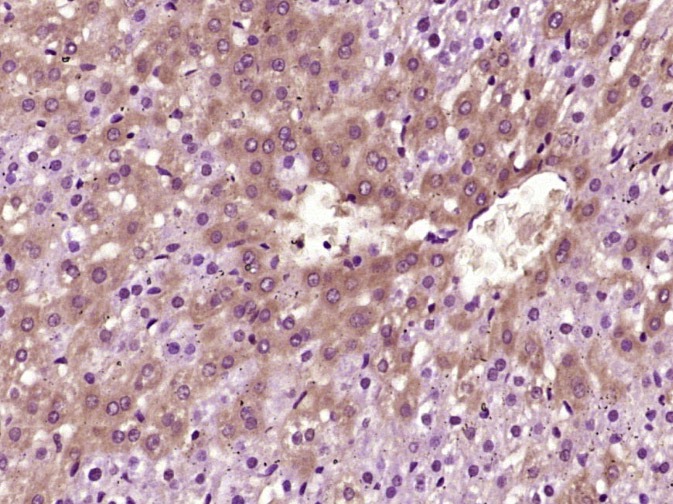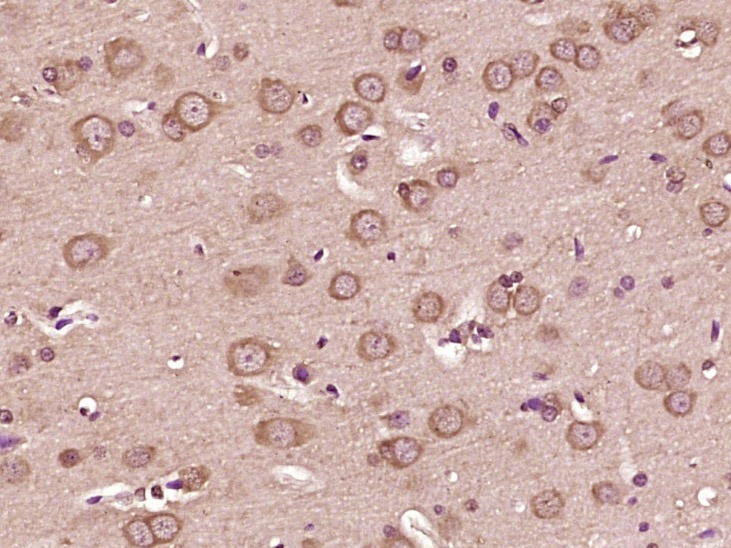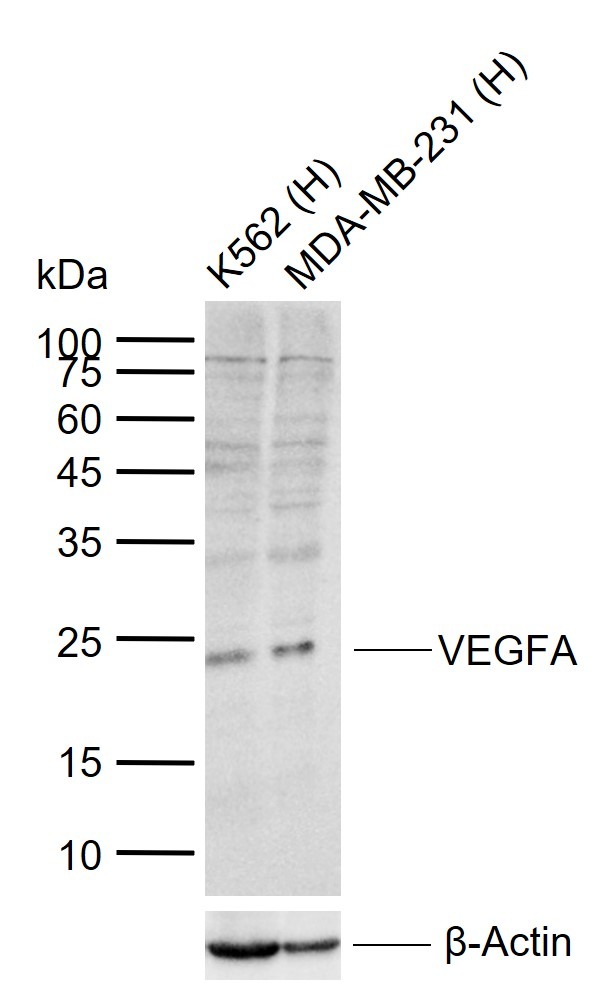Shopping Cart
Remove All Your shopping cart is currently empty
Your shopping cart is currently empty
Anti-VEGFA Polyclonal Antibody 5 is a Rabbit antibody targeting VEGFA. Anti-VEGFA Polyclonal Antibody 5 can be used in IF,IHC-Fr,IHC-P,WB.
| Pack Size | Price | USA Warehouse | Global Warehouse | Quantity |
|---|---|---|---|---|
| 50 μL | $220 | 7-10 days | 7-10 days | |
| 100 μL | $373 | 7-10 days | 7-10 days | |
| 200 μL | $527 | 7-10 days | 7-10 days |
| Description | Anti-VEGFA Polyclonal Antibody 5 is a Rabbit antibody targeting VEGFA. Anti-VEGFA Polyclonal Antibody 5 can be used in IF,IHC-Fr,IHC-P,WB. |
| Synonyms | VPF, VEGF-A, VEGF, MVCD1, L-VEGF |
| Ig Type | IgG |
| Reactivity | Human,Rat (predicted:Dog) |
| Verified Activity | 1. Sample: Cerebellum (Rat) Lysate at 40 μg Kidney (Rat) Lysate at 40 μg Cerebrum (Rat) Lysate at 40 μg Liver (Rat) Lysate at 40 μg Primary: Anti-VEGFA (TMAB-01952) at 1/1000 dilution Secondary: IRDye800CW Goat Anti-Rabbit IgG at 1/20000 dilution Predicted band size: 43/23 kDa Observed band size: 23 kDa 2. Paraformaldehyde-fixed, paraffin embedded (rat liver tissue); Antigen retrieval by boiling in sodium citrate buffer (pH6.0) for 15 min; Block endogenous peroxidase by 3% hydrogen peroxide for 20 min; Blocking buffer (normal goat serum) at 37°C for 30 min; Antibody incubation with (VEGFA) Polyclonal Antibody, Unconjugated (TMAB-01952) at 1:400 overnight at 4°C, followed by operating according to SP Kit (Rabbit) instructionsand DAB staining. 3. Paraformaldehyde-fixed, paraffin embedded (rat brain tissue); Antigen retrieval by boiling in sodium citrate buffer (pH6.0) for 15 min; Block endogenous peroxidase by 3% hydrogen peroxide for 20 min; Blocking buffer (normal goat serum) at 37°C for 30 min; Antibody incubation with (VEGFA) Polyclonal Antibody, Unconjugated (TMAB-01952) at 1:400 overnight at 4°C, followed by operating according to SP Kit (Rabbit) instructionsand DAB staining. 4. Sample: Lane 1: Human K562 cell lysates Lane 2: Human MDA-MB-231 cell lysates Primary: Anti-VEGFA (TMAB-01952) at 1/1000 dilution Secondary: IRDye800CW Goat Anti-Rabbit IgG at 1/20000 dilution Predicted band size: 24 kDa Observed band size: 24 kDa     |
| Application | |
| Recommended Dose | WB: 1:500-2000; IHC-P: 1:100-500; IHC-Fr: 1:100-500; IF: 1:100-500 |
| Antibody Type | Polyclonal |
| Host Species | Rabbit |
| Subcellular Localization | Secreted. Note=VEGF121 is acidic and freely secreted. VEGF165 is more basic, has heparin-binding properties and, although a signicant proportion remains cell-associated, most is freely secreted. VEGF189 is very basic, it is cell-associated after secretion and is bound avidly by heparin and the extracellular matrix, although it may be released as a soluble form by heparin, heparinase or plasmin. |
| Tissue Specificity | soform VEGF189, isoform VEGF165 and isoform VEGF121 are widely expressed. Isoform VEGF206 and isoform VEGF145 are not widely expressed. |
| Construction | Polyclonal Antibody |
| Purification | Protein A purified |
| Appearance | Liquid |
| Formulation | Preservative: 0.02% Proclin300, Constituents: 1% BSA, 0.01M PBS, pH7.4. |
| Concentration | 1 mg/mL |
| Research Background | Vascular endothelial growth factor (VEGF), originally known as vascular permeability factor (VPF), is a signal protein produced by cells that stimulates the formation of blood vessels. To be specific, VEGF is a sub-family of growth factors, the platelet-derived growth factor family of cystine-knot growth factors. They are important signaling proteins involved in both vasculogenesis (the de novo formation of the embryonic circulatory system) and angiogenesis (the growth of blood vessels from pre-existing vasculature). |
| Immunogen | KLH conjugated synthetic peptide: human VEGFA |
| Antigen Species | Human |
| Gene Name | VEGFA |
| Gene ID | |
| Protein Name | Vascular endothelial growth factor A |
| Uniprot ID | |
| Biology Area | VEGF,SARS Coronavirus,Cancer,Hypoxia,Co-factors,Angiogenesis and vasculogenesis,VEGF,Angiogenic growth factors,VEGF,Response to hypoxia |
| Function | Growth factor active in angiogenesis, vasculogenesis and endothelial cell growth. Induces endothelial cell proliferation, promotes cell migration, inhibits apoptosis and induces permeabilization of blood vessels. Binds to the FLT1/VEGFR1 and KDR/VEGFR2 receptors, heparan sulfate and heparin. NRP1/Neuropilin-1 binds isoforms VEGF-165 and VEGF-145. Isoform VEGF165B binds to KDR but does not activate downstream signaling pathways, does not activate angiogenesis and inhibits tumor growth. |
| Molecular Weight | Theoretical: 24 kDa. |
| Stability & Storage | Store at -20°C or -80°C for 12 months. Avoid repeated freeze-thaw cycles. |
| Transport | Shipping with blue ice. |
| Size | Quantity | Unit Price | Amount | Operation |
|---|

Copyright © 2015-2025 TargetMol Chemicals Inc. All Rights Reserved.